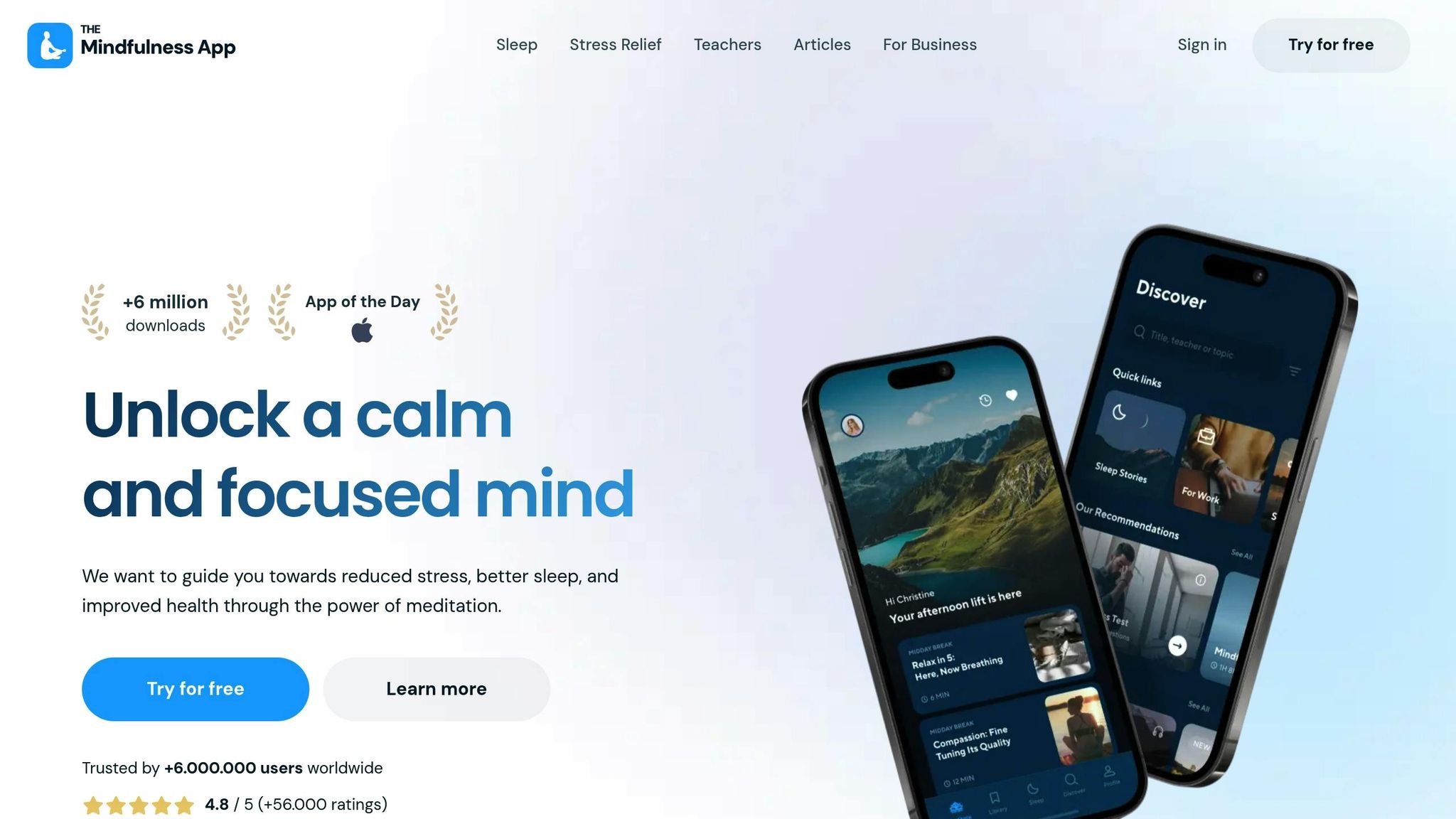Mindful communication is a way to handle tough conversations with awareness, purpose, and kindness. It focuses on staying present, listening deeply, and responding thoughtfully rather than reacting impulsively. Stressful conversations often lead to misunderstandings and emotional strain, but mindfulness can help you navigate these moments calmly and effectively.
Key Takeaways:
- Active Listening: Focus fully on the speaker, paraphrase their points, and ask clarifying questions to ensure understanding.
- Emotional Awareness: Recognize your triggers and use techniques like deep breathing to stay calm and composed.
- 3 P's (Precision, Pace, Pause): Speak clearly, maintain a steady pace, and pause before responding to avoid reactive comments.
- Grounding Techniques: Use methods like the 5-4-3-2-1 exercise or square breathing to stay present during tense moments.
- Nonverbal Communication: Align your body language with your words to build trust and reduce tension.
Practical Steps:
- Prepare: Set clear intentions, choose a quiet space, and center yourself with deep breathing before the conversation.
- During the Talk: Stay mindful of your emotions, listen actively, and pause when needed to collect your thoughts.
- Afterward: Reflect on what went well, identify areas for improvement, and practice self-care to manage lingering emotions.
By practicing these techniques regularly, you can improve your communication skills, reduce stress, and build stronger connections in both personal and professional settings.
A Guided Meditation on Practicing Mindful Speech and Communication With Dr. Kate Truitt
Core Principles of Mindful Communication
Mindful communication is built on three key principles that help us navigate challenging conversations with clarity and intention. These principles provide a solid foundation for staying calm and present, even when emotions run high. Let’s break down each principle and see how it can guide meaningful dialogue in stressful situations.
Active Listening
In stressful conversations, active listening is about giving someone your full attention and genuinely trying to understand their perspective. This means tuning into their words, observing their body language, and staying focused without distractions. It also involves paraphrasing what they’ve said and asking clarifying questions to ensure you’re on the same page .
Simple actions like maintaining eye contact and nodding show you’re engaged. If the discussion veers off course, gently redirect it back to the main issue. These small but intentional steps help diffuse tension, foster understanding, and create a space where both sides feel heard.
Emotional Awareness and Self-Regulation
Keeping your emotions in check is crucial during heated conversations. Emotional regulation helps you avoid reactive responses that might escalate the situation. It’s about staying calm under pressure so you can think clearly and respond thoughtfully.
Start by recognizing your emotional triggers and the physical signs of stress, like tight shoulders, shallow breathing, or growing frustration. Techniques such as rolling your shoulders back and taking deep breaths can ease physical tension and help you regain composure.
"Emotional self-control - delaying gratification and stifling impulsiveness - underlies accomplishment of every sort." – Daniel Goleman
Before replying, pause for 5–10 seconds to collect your thoughts and choose a measured response. Research shows that leaders who cultivate empathy perform over 40% better in areas like coaching, engagement, and decision-making. This principle underscores the importance of staying grounded and empathetic, even when conversations get tough.
The 3 P's: Precision, Pace, and Pause
The "3 P's" - Precision, Pace, and Pause - are tools for communicating effectively during stressful moments. Precision involves speaking clearly and concisely to avoid misunderstandings, while Pace encourages measured, steady speech to keep the conversation calm.
The Pause is perhaps the most impactful of the three. It gives you a moment to reflect before responding, creating a crucial gap between stimulus and reaction. This pause allows you to choose your words carefully and respond with intention.
"Between stimulus and response there is a space. In that space is our power to choose our response. In our response lies our growth and our freedom." – Viktor Frankl
By applying these principles, you bring focus and clarity to your interactions, ensuring the conversation moves toward resolution rather than conflict. Staying present and attentive not only helps you respond thoughtfully but also builds a stronger connection with the other person.
The ripple effects of mindful communication go beyond one-on-one interactions. Companies that prioritize consistent, mindful communication report a 33% increase in revenue, and 76% of customers prefer to buy from brands they feel connected to. This shows the power of clear and intentional dialogue in fostering trust and collaboration.
Practical Techniques for Stressful Conversations
Handling stressful conversations can be challenging, but there are practical techniques to help you stay calm and focused. Rooted in mindful communication, these methods are actionable and effective for real-life situations.
Mindful Listening
Mindful listening isn’t just about hearing words - it’s about being fully present and attentive to what the speaker is saying, as well as understanding the emotions and nonverbal cues behind their words.
"Mindful listening means giving full attention to the speaker and trying to understand the complete message being communicated." – Patti Vitale, Author
To practice mindful listening, give the speaker your undivided attention. Eliminate distractions like phones or background noise to focus completely. Instead of formulating a response while they’re speaking, make an effort to truly understand their perspective. Acknowledge their thoughts and feelings without judgment - this can help the other person feel heard and more willing to engage constructively.
Pay attention to tone and body language, as these often reveal just as much as the words themselves. One effective technique is paraphrasing what you’ve heard. For instance, you might say, “So you arrived at the meeting on time but felt like your input wasn’t acknowledged.” This not only shows you’re processing their message but also gives them an opportunity to clarify if needed.
Here’s a quick reference table summarizing key mindful listening techniques:
| Technique | Purpose | How to Apply It | Example |
|---|---|---|---|
| Paraphrasing | Show interest and encourage sharing | Restate their message in your own words | "You felt your ideas weren’t appreciated." |
| Verbalizing Emotions | Reflect their feelings to show understanding | Acknowledge their emotions explicitly | "That must have been really frustrating." |
| Clarifying | Ensure you understand their point clearly | Ask questions about unclear statements | "When you said you reacted, what happened next?" |
| Summarizing | Highlight key points to confirm understanding | Recap major ideas and emotions | "So, these are the main concerns you’ve shared:" |
These strategies help lay the groundwork for managing your own emotions, which is crucial for keeping the conversation productive.
Grounding and Managing Emotions
Once you’ve mastered listening, the next step is to manage your own emotional and physical reactions. Stressful conversations can trigger the "fight or flight" response, making it harder to think clearly. Grounding techniques can help you stay present and regain control.
"Grounding techniques help control these symptoms by turning attention away from thoughts, memories, or worries, and refocusing on the present moment." – Woody Schuldt, LMHC
One effective grounding exercise is the 5-4-3-2-1 technique. Identify five things you can see, four you can touch, three you can hear, two you can smell, and one you can taste. This simple practice shifts your focus from overwhelming emotions to physical sensations, helping you stay calm.
Breathing exercises are another powerful tool. Try square breathing: inhale for four counts, hold for four, exhale for four, and hold for four. Alternatively, the 4-7-8 technique involves inhaling for four counts, holding for seven, and exhaling slowly for eight. Both methods activate your body’s relaxation response almost immediately.
Physical grounding can also be helpful. Immerse your hands in water, hold a smooth object, or press your feet firmly into the ground. These tactile experiences anchor you in the present and provide a sense of stability when emotions feel overwhelming.
The key to success is regular practice. Use these techniques even during calm moments so they become second nature. That way, you can apply them as soon as stress begins to build, rather than waiting until it’s too late.
Nonverbal Communication
Your body language plays a vital role in how your message is received. Nonverbal cues like posture, facial expressions, and tone of voice can either build trust or create tension.
"We convince by our presence." – Walt Whitman
To align your body language with your words, maintain an open posture. Keep your arms uncrossed, relax your shoulders, and lean slightly forward to show engagement. Mixed signals, such as saying you’re open to dialogue while appearing closed off, can undermine your message.
When stress creeps in, it can affect your tone and gestures. Take a moment to relax your jaw, soften your gaze, and steady your breathing to avoid sending unintended signals. Similarly, pay attention to the other person’s nonverbal cues. If they say they’re fine but their voice is shaky or fists are clenched, you might respond with, “I hear you saying you’re okay, but you seem upset. Would you like to talk about it?”
Approach every interaction with an open attitude. Avoid dismissive gestures like eye-rolling or sighing, as these can escalate tension. Instead, use active listening behaviors - nod, maintain eye contact, and encourage them with phrases like “I see” or “Tell me more about that.” This helps foster understanding and keeps the conversation on track.
Step-by-Step Process for Managing Stressful Conversations
Using mindful communication techniques, you can turn stressful conversations into moments of growth and understanding. This approach helps you prepare mentally, stay grounded during the discussion, and reflect afterward to improve future interactions.
Preparing for the Conversation
Taking just a few minutes to center yourself can make a big difference. Mental and emotional preparation through mindfulness gives you clarity and balance before diving into a tough discussion.
Start by setting clear intentions. Think about what a positive outcome would look like for both parties. This isn’t about proving a point or "winning" - it’s about understanding each other and finding common ground. When emotions run high, having a clear goal keeps you focused.
"Taking as little as three minutes to mentally prepare can help you 'have a genuine human interaction with the person, as a sign of respect for them and for your relationship.'" – Matthew Bellows
Choose an environment that supports the conversation. Find a private, quiet space where distractions are minimal. Turn off your phone notifications, close your laptop, and make sure you won’t be interrupted.
Intentional breathing can also help. Try a simple technique: inhale slowly for four counts, hold for four, and exhale for four. Once you’ve prepared, you’re ready to engage mindfully as the conversation unfolds.
During the Conversation
When the conversation begins, your preparation lays the groundwork, but staying mindful takes ongoing effort. Pay attention to your internal state and manage your emotions as they arise. Notice physical sensations - feel your feet on the ground, observe your breathing, and check for tension in your shoulders or jaw.
If emotions start to escalate, pause briefly. A simple “One moment, please” can give you the time you need to regain composure. This pause helps you avoid reacting impulsively, allowing for a more thoughtful response.
"With mindful presence and skill, we can shift these patterns by carving new conduits into the hillside of our mind and body, creating different streams for that energy to follow." – Oren Jay Sofer
Use physical grounding techniques to stay centered. Feel the weight of your body in the chair, imagine a string pulling you gently upward, or focus on where your body makes contact with the floor or seat. These small actions can help you stay present.
Be mindful of the pace of the conversation. Look for natural pauses to reflect before responding. If you feel overwhelmed, it’s okay to take a break. You might say, “I care about resolving this, but I need a moment to collect my thoughts. Can we pause and continue shortly?”.
Throughout the discussion, express your intentions openly. Let the other person know you’re committed to understanding their perspective and working together to find a solution.
After the Conversation
The work doesn’t stop when the conversation ends. Reflection is a key step in learning from the experience and preparing for future interactions.
Start by pausing and taking a deep breath to shift out of “conversation mode.” Ask yourself, “What do I notice right now?” This simple question helps you reconnect with your emotional and physical state.
Be kind to yourself as you reflect. Difficult conversations are challenging for everyone, and the goal isn’t perfection. Think about what you need to care for yourself and the situation in a way that feels constructive.
Evaluate what went well and what didn’t. When did you feel most connected? Where did you notice yourself becoming reactive? Use these insights to guide how you might approach similar situations in the future. This isn’t about criticism - it’s about growth.
Celebrate your efforts, no matter how small. Maybe you stayed calm when you normally wouldn’t, or you truly listened when the other person shared something vulnerable. Recognizing these moments reinforces positive behavior.
If lingering emotions surface, try the "Stop-Breathe-Reflect-Choose" method. Pause what you’re doing, take a deep breath, reflect on your feelings, and decide how you want to respond.
Finally, remind yourself that emotions and thoughts aren’t always facts. If you catch yourself replaying the conversation or making assumptions about the other person’s intentions, bring your focus back to what was actually said and observed. This practice helps you stay grounded in reality.
sbb-itb-bea8dce
Resources for Building Mindful Communication Skills
Effective mindful communication not only eases stress but also nurtures stronger connections. Developing these skills doesn’t require a complete lifestyle overhaul. Small, intentional changes can make a big difference in how you handle challenging conversations.
Adding Mindfulness to Daily Routines
Mindful communication starts with being present in your everyday life. By weaving mindfulness into your routine, you can improve your ability to stay calm and focused, even during tough conversations.
Morning mindfulness can set the tone for a balanced day. Before diving into the chaos of daily life, take a few quiet moments to breathe deeply and set a clear intention - like practicing patience or kindness - that you can return to throughout the day.
Mindful breathing is a simple yet effective way to manage stress. Techniques like one-minute relaxation breathing or square breathing (inhale for four counts, hold for four, exhale for four, hold for four) can help you stay grounded in the moment.
Body scan meditation is another powerful tool to connect with your emotions and reduce reactivity. By focusing on each part of your body, you can release tension and reconnect with the present. Meditation teacher Karim Rushdy explains:
"The body, like the breath, is always here waiting to transport us back to the present moment. Learning to be at home in the body allows us to reconnect and reduce the emotional reactivity stored in it."
Loving-kindness meditation encourages compassion for yourself and others by repeating positive affirmations. Rushdy shares how this practice impacted his life:
"Through regular loving-kindness practice, I was able to heal a strained relationship with my father. It opened my heart in profound ways."
Even simple activities like walking or eating can become mindfulness exercises. Mindful walking involves focusing on the sensations in your feet while syncing your steps with your breath. Mindful eating encourages you to savor each bite, noticing the colors, textures, and flavors of your food without distractions.
For added support, digital tools like The Mindfulness App can help structure and enhance these practices.
Using The Mindfulness App

To complement your daily mindfulness efforts, The Mindfulness App offers guided resources to help you stay on track. With over 500 guided meditations, courses, and sleep stories available in 12 languages, it’s designed to reduce stress and improve overall well-being.
The app’s effectiveness is reflected in user feedback - 89% of users reported feeling calmer and less stressed after just one week of using its 5-minute daily sessions.
Features like breathwork exercises, body scan meditations, and reminders for mindful breaks make it easier to manage emotions throughout the day. Offline access ensures you can practice anytime, anywhere. Michael from the USA shares his experience:
"Excellent app to keep you on your meditation program. I can HIGHLY recommend! So many options within the app to choose from."
You can try the app with a 14-day free trial, which gives full access to the premium library. After the trial, premium plans are available for $9.99 per month or $79.99 per year.
Building a Personal Mindfulness Practice
Consistency is crucial when it comes to developing mindfulness skills. The key is to find practices that suit your lifestyle and keep you motivated.
Start small - just five minutes a day can make a noticeable difference in how you approach difficult conversations. The Mindfulness App offers various session lengths, so you can choose what works best for your schedule, whether it’s a quick two-minute exercise or a more in-depth 20-minute session.
Incorporate mindfulness into your existing routines instead of setting aside extra time. For instance, practice mindful breathing while waiting for your coffee, do a body scan before bed, or take a walking meditation during your lunch break.
Explore different techniques to find what resonates with you. The app’s extensive library includes practices like focused breathing and loving-kindness meditation, allowing you to tailor your mindfulness journey to your unique needs and challenges.
Finally, create mindful pauses during your day to shift from reacting automatically to responding thoughtfully. As Stephen Covey wisely noted:
"Most people do not listen with the intent to understand; they listen with the intent to reply."
Conclusion: Key Takeaways for Mindful Communication
Mindful communication equips you to navigate tough conversations with clarity, empathy, and purpose. These practices help you respond thoughtfully, strengthen relationships, minimize misunderstandings, and build trust that lasts.
The techniques outlined here bridge the gap between theory and action. Studies reveal that mindful communication training improves relationships among college students and healthcare professionals, while also boosting emotional resilience and uplifting mood. By practicing active listening, emotional awareness, and the 3 P's - Precision, Pace, and Pause - you create an environment where genuine understanding can thrive.
As we’ve explored, tools like active listening and emotional self-regulation are foundational. Active listening ensures you fully grasp others' perspectives, while emotional self-regulation helps keep personal stress from escalating conflicts. The S.T.O.P. technique - Stop, Take a Breath, Observe, Proceed - offers a practical, in-the-moment strategy for managing heated exchanges.
Psychologist Peter Shepherd emphasizes the transformative power of communication:
"Communication is a solvent of all life problems and is the foundation for personal development."
This insight underscores the importance of honing these skills. Each challenging conversation is a chance to grow closer to others.
Consistency matters. Incorporate mindful breathing or the S.T.O.P. technique into your daily interactions. Thich Nhat Hanh reminds us that mindful communication is about more than politeness:
"Mindful communication isn't just about being polite. It's about being truly present in your conversations, listening deeply, and responding thoughtfully."
Whether dealing with workplace conflicts or personal disagreements, these approaches help you stay grounded while fostering mutual understanding.
For additional support, resources like The Mindfulness App's guided meditations can reinforce these practices. With regular use, overwhelming moments become more manageable, and difficult conversations transform into opportunities for respect and connection. By applying these strategies, you can enrich every dialogue you engage in.
FAQs
How can I use mindful communication to improve my daily interactions and handle stressful conversations?
Incorporating mindfulness into your daily interactions can start with small, intentional steps like mindful breathing and active listening. Before jumping into a conversation, take a moment to center yourself by focusing on your breath. Once you're engaged, give the other person your undivided attention - listen fully, without interrupting or passing judgment.
Adding a few minutes of self-reflection or a body scan to your daily routine can also help you develop greater emotional awareness. These practices build resilience and help you manage stress, allowing you to approach difficult conversations with a calm and empathetic mindset.
If you’re looking to deepen your mindfulness practice, tools like guided meditations or mindfulness courses can be great resources to enhance your skills and improve your sense of well-being.
How can I use mindful communication to prepare for a stressful conversation?
Preparing for a tough conversation can feel overwhelming, but starting with focused breathing can make a big difference. Taking a moment to calm your mind and center yourself helps you enter the discussion with a clear head and a steady demeanor.
Once the conversation begins, try practicing active listening. Give the other person your full attention, repeat or paraphrase what they’ve said to confirm you understand, and allow space for silence so both of you can process your thoughts. These small steps can foster mutual respect and minimize potential misunderstandings.
Making mindfulness part of your daily life - like taking time to pause and reflect, staying grounded in the present, and approaching situations calmly - can gradually build your ability to handle challenging conversations with greater empathy and patience. Over time, these habits can make navigating difficult discussions feel a little less daunting.
How can grounding techniques help you stay calm during difficult conversations?
Grounding Techniques for Difficult Conversations
Grounding techniques can help you stay calm and focused during tough conversations. They work by anchoring your attention to the present moment, which can ease emotional tension and give you the clarity to respond thoughtfully.
Simple methods like deep breathing, paying attention to physical sensations (such as the pressure of your feet on the floor), or picturing a peaceful scene can make a big difference. Staying grounded allows you to express yourself more clearly and with empathy, even when the situation feels overwhelming.






